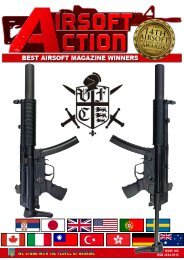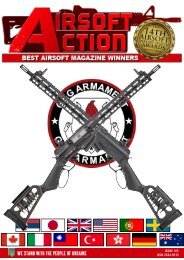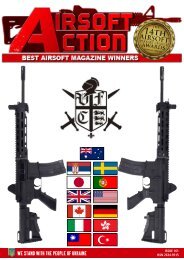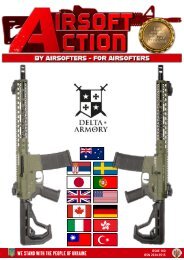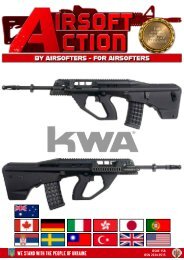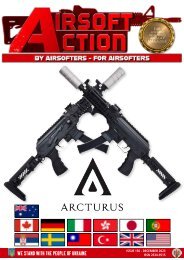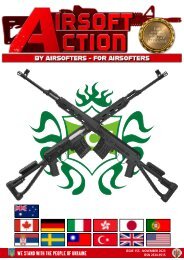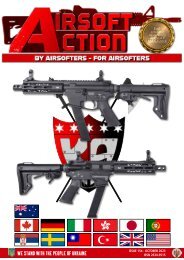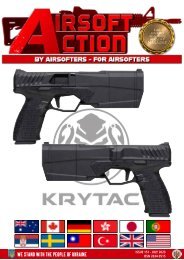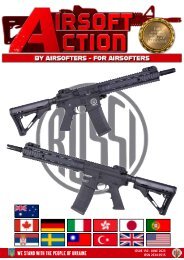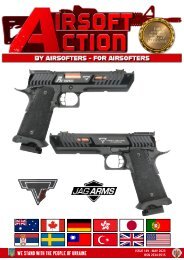PMCI - February 2017
Welcome to a whole new year of Private Military Contractor International. The team hit the ground running with this issue following a very successful visit to SHOT Show 2017 in Las Vegas which is reported fully. This issue also has an in depth interview with Dark Angel Medical and reviews of new knives and tools from SOG, an innovative lighting system for your AR and an overview of a revolutionary new training tool. If you’re working in the private military sector then PMCI is the magazine for you!
Welcome to a whole new year of Private Military Contractor International.
The team hit the ground running with this issue following a very successful visit to SHOT Show 2017 in Las Vegas which is reported fully.
This issue also has an in depth interview with Dark Angel Medical and reviews of new knives and tools from SOG, an innovative lighting system for your AR and an overview of a revolutionary new training tool.
If you’re working in the private military sector then PMCI is the magazine for you!
Create successful ePaper yourself
Turn your PDF publications into a flip-book with our unique Google optimized e-Paper software.
The three belts that I have included here use different ways of<br />
securing the belt. Component battle belts consist of a MOLLE<br />
pad with a separate belt that is threaded through the pad. The<br />
buckles on the belt can be of any type as you can use any belt<br />
that is suitable. The most common component battle belts in<br />
use have a quick release clip or roll pin buckle. The choice of<br />
what belt and fastening system you go for is a luxury you have<br />
when choosing a component battle belt. Some battle belts have<br />
an integrated buckle system that is attached directly to the belt<br />
by means of webbing strap or strips with an adjustable buckle<br />
system. Integrated buckles, although fully adjustable, need to<br />
be fixed or discarded if the belt should break. Component belts,<br />
however, are fixed by simply replacing the broken belt for a new<br />
one. Any belt will do so long as it is wide enough to support<br />
the MOLLE pad. I’ve even seen a battle belt being held together<br />
with 550 cord and cable ties after the buckle on the belt broke;<br />
a quick battlefield fix until a new belt could be found.<br />
CIVVY AND MIL<br />
Battle belts are not always seen or used in areas of conflict. My<br />
civilian range belt has a similar setup as my duty battle belt.<br />
Consisting of a 2 inch wide belt, (without a pad), leather holster,<br />
magazine pouches, PFAK (Personal First Aid Kit), this setup allows<br />
me to continue with my training but without looking like Rambo<br />
down on my local firearms range. Many civilian ranges these<br />
days tend to shy away from the military look. As I don’t spend<br />
all day at the range with my belt around my waist, I don’t feel<br />
the need for a pad. The padding provides comfort and support<br />
when the battle belt is fully laden with kit. There are several<br />
widths and thicknesses of padding as well as materials.<br />
If the padding is too thick then the belt will tend to lose grip<br />
and move around when you move. Likewise if the belt is too<br />
wide the belt also tends to move. A good amount of MOLLE strips<br />
to secure your kit is three, but I have found that a minimum of<br />
two works fine. This will enable you to have two rows of MOLLE<br />
and some extra padding above and below the strips without<br />
making the belt too wide. This will make the belt a lot narrower<br />
and still afford maximum comfort and grip during use.<br />
Depending on the intended use of your battle belt, you<br />
will need to consider not only the amount of MOLLE you have<br />
but also the width, thickness, and padding including the inner<br />
lining material. The amount of kit you will be carrying also<br />
needs careful consideration in regards to weight and bulk. Most<br />
setups allow for a ‘free floating’ belt, however, if your battle<br />
belt is going to be laden down with copious amounts of heavy<br />
ammunition, grenades and other supplies then you may need<br />
to consider the use of a yoke or suspenders. Most battle belts<br />
have attachment points built in to accommodate a yoke of some<br />
description. A yoke is a simple design, much like braces, that<br />
helps to keep the belt in place by the straps crossing over your<br />
shoulders. The yoke will help bear a great amount of weight and<br />
prevent the belt from sagging and moving during use. The yoke<br />
will also aid in comfort and release weight from your waist and hips.<br />
The lining of the belt is another important consideration.<br />
Rubber is used in some belts to reduce the movement of the<br />
belt whilst running and during other physical activities. I have<br />
found that a rubber lining rubs after a while and is of no use<br />
in hot and humid climates. Thicker padded mesh lining is, for<br />
me, an all round winner. This is not only comfortable but it also<br />
wicks away sweat from the body and is breathable. However<br />
a pad that is too thick can cause problems by moving around<br />
under heavy physical activity. The thinnest pads use a liner<br />
known as a hard liner. This liner affords very little padding,<br />
yet is still comfortable, and has groves along the pad to aid in<br />
breathing and venting heat away from the body. As for price, the<br />
usual rules apply, bye what you can afford and don’t go for the<br />
cheapest battle belt system. Quality, like many things today, is<br />
usually measured in currency.<br />
GEARING UP<br />
Rigging the battle belt needs to be done right in order for it to<br />
work for you. As a rule you should try to locate your pouches in<br />
the same location every time. If your handgun magazine pouches<br />
are usually on your weak side hip during every day use, then<br />
endeavour to locate them in the same place on your battle belt.<br />
The same goes for the rest of the pouches you may use. I once<br />
tried to wear my handgun on the front of my plate carrier after<br />
carrying strong side hip for over fourteen years. Transitioning<br />
from primary weapon to secondary went drastically wrong<br />
when I reached down to my strong side hip and found there<br />
was no handgun. My training and muscle memory kicked in and<br />
for a moment I was stunned and confused. I soon relocated my<br />
handgun back to my strong side hip. The way in which you rig<br />
your battle belt usually falls into one of three categories. Just<br />
remember that your battle belt is a supplement to your vest<br />
an aid to carry more of what you already carry on your armour.<br />
• Minimalist<br />
A minimalist battle belt can usually be found on the range.<br />
Consisting of a belt, holster, three magazine pouches (1 rifle, 2<br />
handgun) and PFAK, this belt is the bare minimum. There is no<br />
need for all the bells and whistles on this type of belt. Of course<br />
you can add the extra ammo pouch or utility pouch but don’t feel<br />
the need to add pouches just because there is room to fit them.<br />
The only extra pouches I would consider are a dump pouch for<br />
my magazines and a utility pouch for my ear defenders. If you<br />
are going down the range road then choose the same type of<br />
hardware as your duty battle belt but in a more civilian friendly<br />
tone. Try to stay away from the camouflage / military look on<br />
civilian ranges.<br />
TAC GEAR - BATTLE BELTS<br />
pmcimagazine.com




